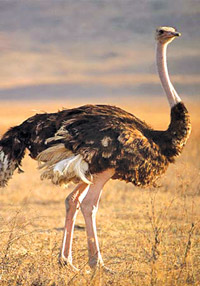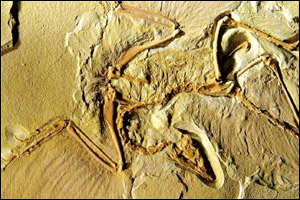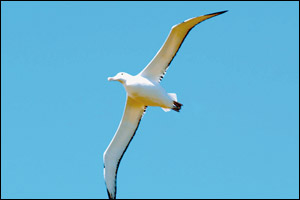Nature trailAvians:
Supreme flyers
-Unique among all other animals due to their feathers, birds are one
of the most fascinating creatures in the Animal Kingdom. They are such
unusual creatures that scientists are finding it difficult to exactly
say from which other creatures they might have evolved from. It is
basically presumed that birds first appeared during the time of
dinosaurs. Going by fossils of a primitive bird found in a quarry in
Germany, scientists say that birds lived about 150 million years ago.
|

A toco toucan |
|

A swan taking off |
The fossils of the primitive bird which the scientist named
Archaeopteryx have revealed that the early birds not only had feathers
and the usual bones of modern day birds, but also reptile like teeth, a
bony tail and claws along its wings. Some scientists are of the view
that birds evolved from reptiles due to the teeth formation and bony
tail of the Archaeoptevyx.
Many others say the present day birds are flying dinosaurs, because
they believe that some of the smaller species of dinosaurs such as the
Compsognathus developed their long feathery scales over the years
enabling them to fly. But how could scales develop into feathers, you
may wonder. The main reason for this view is that scales and feathers
are made from keratin, which is also the substance that forms our hair
and finger nails. Many fossil expert say that these scales could have
easily evolved into feathers by developing the shaft and filaments that
make up the feathers of present day birds.
No matter how or when birds originated, no one can dispute the fact
that they are a wonderful species of animals that add colour and beauty
to our world.
|

A swan taking off |
|

The smallest bird, Bee humingbird and the biggest, the
flightless Ostrich |
Our feathered friends in the avian world are indeed nature's supreme
flyers and their aerial skills cannot be easily duplicated by man.
Birds come in a variety of sizes, with the smallest, the bee
hummingbird weighing no more than a coin, to the largest the gigantic
ostrich which is taller and heavier than even an adult human.
There are over 8600 different kinds of birds distributed throughout
the world from one end of the pole to the other. Just as varied the
birds are, are their lifestyles and habitats.
There is basically no place on Earth that birds are not found. They
live in all kinds of habitats from extreme deserts to freezing pack-ice
zones, on land or in water and from sea level to high mountains. Each
species may display different traits in behaviour and physical
appearance, but in general all birds have many common features; they all
have feathers, beaks, wings and two clawed feet. They also lay eggs and
hatch them. Of cause when it comes to hatching, just like flying, their
are exceptions to the rule. Some lazy birds do not ``hatch' their eggs
by sitting on them as is the common practice with most birds. They use
the heat of volcanic activity, the sun and even rotting vegetation to
hatch their eggs. There are some species of bird which take the easy way
out and lay their eggs in another birds's nest. An ideal way to save
energy, don't you think? And when it comes to flying, even though we
normally associate flying with birds, not all birds have the ability to
fly. Flight becomes virtually impossible for birds weighing over 15 kg.
There are some species who are bordering on the heavy weight limit who
manage to fly, such as the Kori bustard.
It is a turkey-like bird from Europe and Asia which is classed as the
heaviest flyer as it weighs around 12-15 kg. The other is a swan.
|

A drawing of a hoatzin |
|

Fossils of a primitive bird |
Do you know that the swan needs a running start from the surface of a
lake to reach a sufficient speed for take off, because it is so heavy?
Having the ability to fly is so fascinating and birds are indeed
fortunate to be attributed with this skill, naturally. We humans can
only do so with the assistance of artificial equipment such as
parachutes, gas balloons and so on. But why do birds fly when other
animals don't? They do so mostly to find food that other animals cannot
reach and also to escape from ground based predators and extreme weather
conditions
You would be amazed to learn that some birds such as the wandering
albatross can forage for food over a huge area in a very short period of
time without even landing. It hunts for its food while still flying or
'on the wing' as it's generally called.
Birds are fascinating creatures we can never tire of learning about
because there are millions inhabiting the planet. Bird experts believe
that there are over 300 billion birds alive in the world today. That is
roughly about 50 birds for every person on the planet. So, find out more
about these feathered beauties.
Fast facts:
* About 8,500 - 10,000 species of birds survive today in the world.
* Animals with large complex brains such as mammals and birds are
believed to have the ability to learn and adapt to new conditions.
* An ostrich, striding the plains of central and southern Africa can
grow to a height of 2.74m and weigh 160 kg. However, though it is the
largest living bird today it is not the largest bird that ever lived.
Dromarnis stirtoni, a flightless bird like the ostrich thrived in
Australia about 15 million years ago. It reached three metres in height
and weighed up to 500 kg.
|

The wondering albatross |
* A typical bird's feathers are coloured from pigments produced by
the bird itself in its skin or from something it has eaten.
* Feathers weigh about two to three times as much as the bird's
skeleton and account for five to seven per cent of total bodyweight.
* Bills or beaks of birds come in a huge range of shapes, sizes and
colours. They are the main implements a bird uses to catch and eat its
food. It is also vital for preening the feathers to keep them in working
order.
* Some birds such as woodpeckers have specialised beaks they use as a
tool like a chisel or drill to bore holes.
* The toco toucan has a huge beak that is about 19 cm long.
* The young hoatzin, a bird found in the forests of Brazil is said to
have 'four-feet' because it has claws on its wings. The chick uses its
claws to climb back up to a tree when it falls out of its nest. The
claws are shed before adulthood.
* The peregrine falcon is the fastest flying bird. It has been
estimated to reach speeds up to 320 km/h as it stoops out of the sky to
attack prey.
* Different species of bird have different wing beats. Herons are
among those with the slowest wing beats. They flap their wings at a lazy
two or three times a second while most birds beat their wings at between
three and eight times a seconds.
* Hummingbirds must reach rates of 78 beats per second in order to
hover. The wings appear as a blur then. |

